bombing
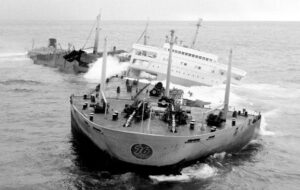 SS Torrey Canyon was a supertanker that was responsible for one of the world’s most serious oil spills. The Torrey Canyon ran aground on rocks off the south-west coast of the United Kingdom in 1967. In all 25 -36 million gallons of crude oil was spilled. There were a number of attempts to mitigate the damage, one of which was to actually bomb the wreck by aircraft from the Royal Navy and Royal Air Force. I guess they thought the bombing would burn up the oil. Unfortunately, that was not the case, and hundreds of miles of coastline in Britain, France, Guernsey, and Spain were affected by the oil spill and other substances used in the attempt to mitigate damage. Even the “solution” was a big problem. The disaster was the world’s worst oil spill and led to significant changes in maritime law and oil spill responses.
SS Torrey Canyon was a supertanker that was responsible for one of the world’s most serious oil spills. The Torrey Canyon ran aground on rocks off the south-west coast of the United Kingdom in 1967. In all 25 -36 million gallons of crude oil was spilled. There were a number of attempts to mitigate the damage, one of which was to actually bomb the wreck by aircraft from the Royal Navy and Royal Air Force. I guess they thought the bombing would burn up the oil. Unfortunately, that was not the case, and hundreds of miles of coastline in Britain, France, Guernsey, and Spain were affected by the oil spill and other substances used in the attempt to mitigate damage. Even the “solution” was a big problem. The disaster was the world’s worst oil spill and led to significant changes in maritime law and oil spill responses.
The Torrey Canyon was built in the United States in 1959. She originally had a capacity of 60,000 tons, but that was later enlarged to 120,000 tons in Japan. She was named for Torrey Canyon, a valley located in Ventura County, California. SS Torrey Canyon was registered in Liberia and owned by Barracuda Tanker Corporation, which is a subsidiary of Union Oil Company of California, but she was chartered to British Petroleum. SS Torrey Canyon was 974.4 feet long, with a 125.4 feet beam and a 68.7 feet draught.
On February 19, 1967, SS Torrey Canyon began what was to be her final voyage. She left the Kuwait National Petroleum Company refinery at Mina Al-Ahmadi, Kuwait, which was later called Al-Ahmadi, with a full cargo of crude oil. The ship was bound for Milford Haven in Wales. By March 14, she reached the Canary Islands. After 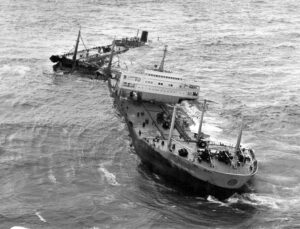 that, things went wrong. It all started with a navigational error and ended when Torrey Canyon struck Pollard’s Rock on the extreme Western end of the Seven Stones between the Cornish mainland and the Isles of Scilly on March 18, 1967.
that, things went wrong. It all started with a navigational error and ended when Torrey Canyon struck Pollard’s Rock on the extreme Western end of the Seven Stones between the Cornish mainland and the Isles of Scilly on March 18, 1967.
Because SS Torrey Canyon did not have a scheduled route and she also didn’t have the necessary complement of full-scale charts of the Scilly Islands. Before long the crew of the SS Torrey Canyon found themselves on a collision course with a fishing fleet. The Master and the officer of the watch disagreed as to their exact position. Uncertainty as to whether the vessel was in manual or automatic steering mode significantly delayed corrective action, with the Master mistakenly believing he had switched the steering to manual for the helmsman. By the time they realized that they had not corrected the steering problem, they were too close to the rocks, and a grounding was unavoidable. Thus, began hours and days of extensive attempts to float the vessel off the reef, all of which failed and even resulted in the death of Captain Hans Barend Stal, a member of the Dutch salvage team.
Despite repeated attempts, the ship would not move off the rocks, and began to break up. Immediately thereafter, the focus changed to concentrating on the clean-up and containment of the resulting oil spill. The Cornwall Fire Brigade used huge amounts of detergent and attending Royal Navy vessels to try to disperse the oil. Then the UK Prime Minister Harold Wilson and his cabinet held a mini cabinet meeting at the Royal Naval Air Station Culdrose. The decision was made to set fire to the vessel and surrounding oil slick to limit the extent of the oil disaster. Then, on March 28, 1967, the Fleet Air Arm sent Blackburn Buccaneer planes from RNAS Lossiemouth to drop forty-two 1,000-pound bombs on the ship. The Royal Air Force sent Hawker Hunter jets  from RAF Chivenor to drop cans of aviation fuel to make the oil blaze. Unfortunately, exceptionally high tides put the fire out. The winds made it necessary to make further bombing runs by Sea Vixens from the RNAS Yeovilton and Buccaneers from the Royal Navy Air Station Brawdy, as well as more RAF Hunters with liquefied petroleum jelly, also known as napalm, to ignite the oil. The constant bombing lasted into the next day before the Torrey Canyon finally sank. About 161 1,000-pound bombs, 13,000 US gallons of kerosene, 3,600 US gallons of napalm and 16 other missiles had been aimed at the ship. Attempts to use foam-filled containment booms were mostly ineffectual because of the high seas. The disaster finally over, there was nothing left but the cleanup.
from RAF Chivenor to drop cans of aviation fuel to make the oil blaze. Unfortunately, exceptionally high tides put the fire out. The winds made it necessary to make further bombing runs by Sea Vixens from the RNAS Yeovilton and Buccaneers from the Royal Navy Air Station Brawdy, as well as more RAF Hunters with liquefied petroleum jelly, also known as napalm, to ignite the oil. The constant bombing lasted into the next day before the Torrey Canyon finally sank. About 161 1,000-pound bombs, 13,000 US gallons of kerosene, 3,600 US gallons of napalm and 16 other missiles had been aimed at the ship. Attempts to use foam-filled containment booms were mostly ineffectual because of the high seas. The disaster finally over, there was nothing left but the cleanup.
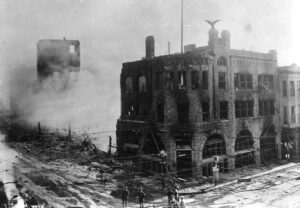 These days, terrorist attacks are…if not common, expected to happen at some point. It’s the crazy world we now live in, but in 1910, it wasn’t quite so common. Nevertheless, on October 1, 1910, there was a massive explosion that destroyed the Los Angeles Times building in the LA’s downtown area. The bombing killed 21 people and injuring many more. Harrison Otis, who was the Los Angeles Times publisher and a bitter opponent of unions, believed that the bomb was directed at him. So, he hired William J Burns, the nation’s top private detective to find out who the culprits were. Otis, in addition to printing numerous editorials against unions, was the leader of the Merchants and Manufacturing Association, which was a powerful group of business owners, all of whom had extensive political connections.
These days, terrorist attacks are…if not common, expected to happen at some point. It’s the crazy world we now live in, but in 1910, it wasn’t quite so common. Nevertheless, on October 1, 1910, there was a massive explosion that destroyed the Los Angeles Times building in the LA’s downtown area. The bombing killed 21 people and injuring many more. Harrison Otis, who was the Los Angeles Times publisher and a bitter opponent of unions, believed that the bomb was directed at him. So, he hired William J Burns, the nation’s top private detective to find out who the culprits were. Otis, in addition to printing numerous editorials against unions, was the leader of the Merchants and Manufacturing Association, which was a powerful group of business owners, all of whom had extensive political connections.
The investigation led Burns to the Bridge and Structural Iron Workers Union and their treasurer, John J McNamara. Burns personally arrested McNamara and his brother in Indiana in April 1911, after Burns got a confession out of Ortie McManigal. It seems that McManigal had allegedly been the intermediary between  McNamara and two bomb experts. Burns had no legal authority to arrest anyone, but he did so, and managed to get the brothers to California, where they were scheduled to be prosecuted.
McNamara and two bomb experts. Burns had no legal authority to arrest anyone, but he did so, and managed to get the brothers to California, where they were scheduled to be prosecuted.
As is typical, and even expected, the Union members and left-wing supporters all rallied around the McNamara brothers. They raised a large defense fund, and union representatives pleaded with Clarence Darrow to take the case. Darrow was well known as the best defense attorney in America. He had already managed to get “Big Bill” Haywood, the union leader of the Industrial Workers of the World, off on murder charges in Idaho a few years earlier. After being offered $50,000, Darrow reluctantly took the case. Public opinion supported the McNamara brothers, but the investigation Darrow performed was quickly turning up evidence to prove that the brothers were actually guilty. To make matters worse, members of the defense team tried to bribe the jury, just to keep up with the prosecution’s own bribery tactics. In the end, Darrow worked out a deal with Otis and the prosecutors that the brothers would plead guilty to escape the death penalty, which they did. It was the best he could do for them.
Still, this plan was not acceptable to either side, and Darrow got caught in the middle. Darrow was soon 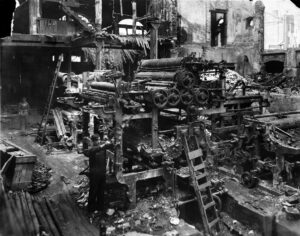 charged with bribery, and Otis arranged for Darrow’s prosecution. The union immediately deserted the great defense lawyer…not only did they refuse to pay his fee for the McNamara case, but they also refused to assist in his defense. Thankfully for Darrow, Earl Rogers, who was a notorious drunk, but also a brash, formidable, and effective Los Angeles attorney, took Darrow’s case. True to his reputation, Rogers managed to secure a mistrial for Darrow. Later, Darrow was acquitted after a second trial. Undaunted, Darrow went on to try even more distinguished cases, including the Leopold and Loeb murder trial and the Scopes evolution trial. Still, I doubt if any trial stood out in his memory quite as much as the trial that almost cost him his freedom.
charged with bribery, and Otis arranged for Darrow’s prosecution. The union immediately deserted the great defense lawyer…not only did they refuse to pay his fee for the McNamara case, but they also refused to assist in his defense. Thankfully for Darrow, Earl Rogers, who was a notorious drunk, but also a brash, formidable, and effective Los Angeles attorney, took Darrow’s case. True to his reputation, Rogers managed to secure a mistrial for Darrow. Later, Darrow was acquitted after a second trial. Undaunted, Darrow went on to try even more distinguished cases, including the Leopold and Loeb murder trial and the Scopes evolution trial. Still, I doubt if any trial stood out in his memory quite as much as the trial that almost cost him his freedom.
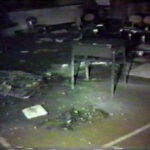
 Friday, May 16, 1986, found the Cokeville, Wyoming law enforcement officers all out of town. It wasn’t normal for every officer to be out of town, but Cokeville was a small town of just 535 people, and normally a quiet place, where nothing ever happened. It was a peaceful place where everyone knew each other. It was a great place to raise a family. Everyone went to church together, worked together, and played together…on a normal day, but this day was not going to be a normal day. This was a miraculous day.
Friday, May 16, 1986, found the Cokeville, Wyoming law enforcement officers all out of town. It wasn’t normal for every officer to be out of town, but Cokeville was a small town of just 535 people, and normally a quiet place, where nothing ever happened. It was a peaceful place where everyone knew each other. It was a great place to raise a family. Everyone went to church together, worked together, and played together…on a normal day, but this day was not going to be a normal day. This was a miraculous day.
That day, around 1:00pm, David Young, a disgruntled and mentally unstable former Cokeville marshal; his wife, Doris; and his youngest daughter, Princess, known as Penny; entered the town’s only elementary school with an arsenal of weapons and a gasoline bomb in a grocery cart. David Young had initially planned to involve longtime friends Gerald Deppe and Doyle Mendenhall. They had invested money with him in a get-rich-quick scheme that he had called “The Biggie.” This, however, was too much for the men, who eventually refused to participate in the event. Both men were handcuffed in a van outside the school.
No one saw this coming. Why would they? Nothing like that had ever happened in Cokeville before. There was still an air of innocence in the town…until that day. The trio entered the school, and Doug Young began threatening the people. It was at this point that Penny also refused to participate and after her dad said she was “no daughter of his” she left to tell the police. Unfortunately, other than the office personnel at the police station, there was no one who could really help, but help was on the way, nevertheless.
As the events unfolded, the Youngs took the school hostage. They had a bomb, and it was leaking gas. The children were getting sick, and teachers felt led to open the windows. Children later said that they saw people dressed in white told them to go near the windows. One teacher felt led to make a box with tape on the floor so that the bomber was in there by himself. No one was allowed in but Doug, the bomber and his wife, Doris. When the bomber went to the restroom, he put the string that would set off the bomb on his wife’s wrist. She forgot not to move her arm up, and she accidently set off the bomb. She was killed. A bomb expert who examined the bomb said that there had been gunpowder under the bomb, and had it not become wet with gasoline, it would have been as if the air was on fire. He also said that several of the wires were cut, and there was no explanation as to how that had happened, but it meant that the bomb didn’t have its full force. The students said they saw beings of light all around the bomb when it went off. Doug came out of the restroom and saw that he had failed. He went back in and fatally shot himself, after shooting one teacher in the back, somehow missing his spine by about an inch. Other 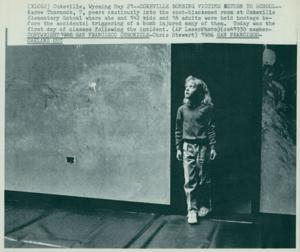
 than that teacher, no one was injured. The bomb did go off, but most of its power was miraculously thwarted. Afterwards, everyone who was there, told the same stories of people dressed in white, and beings of light. No one wavered about what they saw. No one changed their minds. You can believe what you want, but as for me…I believe God sent His angels and gave them charge over the teachers and children at Cokeville Elementary School that day. And the angels bore them up and kept them safe. Glory be to God!!
than that teacher, no one was injured. The bomb did go off, but most of its power was miraculously thwarted. Afterwards, everyone who was there, told the same stories of people dressed in white, and beings of light. No one wavered about what they saw. No one changed their minds. You can believe what you want, but as for me…I believe God sent His angels and gave them charge over the teachers and children at Cokeville Elementary School that day. And the angels bore them up and kept them safe. Glory be to God!!
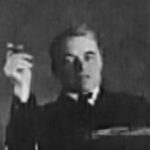
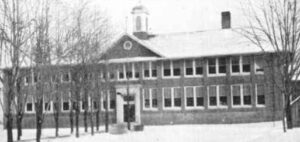 It’s said that there is nothing more dangerous than a humiliated man, and I suppose that could be true, but in the case of Andrew Kehoe, I think there was more to it than just one humiliation. Kehoe had shown violent tendencies since he was a child. Now, I’m not saying that every angry child will grow up to be a monster, but it might be something to monitor. If the violence becomes worse with age, there could be something wrong that needs to be addressed.
It’s said that there is nothing more dangerous than a humiliated man, and I suppose that could be true, but in the case of Andrew Kehoe, I think there was more to it than just one humiliation. Kehoe had shown violent tendencies since he was a child. Now, I’m not saying that every angry child will grow up to be a monster, but it might be something to monitor. If the violence becomes worse with age, there could be something wrong that needs to be addressed.
Andrew Philip Kehoe was born on February 1, 1872 in Tecumseh, Michigan. He was part of a large family. Kehoe showed violent tendencies early on. He tended to blame others for his troubles, which I think is also a common trait in troubled people. Kehoe was notified in June 1926 that his mortgage was going into foreclosure. Andrew Kehoe had been on the school board as treasurer. After his defeat in the April 5, 1926, election for the township clerk Kehoe lost it. Because of his association with the school board, Kehoe set his sights on the Bath School as a target to voice his frustrations. It was the last straw. Kehoe began secretly buying explosives. He hid them on 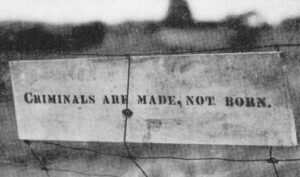 his father’s farm and under the school. On May 18, 1927, Kehoe murdered his wife Nellie Price Kehoe. He then blew up his farm, saying to the firemen as he drove away that they should go to the school instead. Then Kehoe drove off.
his father’s farm and under the school. On May 18, 1927, Kehoe murdered his wife Nellie Price Kehoe. He then blew up his farm, saying to the firemen as he drove away that they should go to the school instead. Then Kehoe drove off.
Kehoe made a sign and hung it on the fence at his farm, saying “Criminals are made, not born.” It was typical of his belief that all of his troubles could logically be blamed on other people, or even on chance events. He never took the blame for his problems himself. Following the bombing of his farm, Kehoe went on to set off the bombs that he hoped would completely destroy the Bath school, and kill everyone in it. Kehoe was disappointed to see that an additional 500 pounds of dynamite that had been set to go off at the same time as the other explosions, failed to detonate. Only a section of the front of the school blew up. Nevertheless, it was enough to kill 38 students and 6 teachers. To this day, the Bath School Massacre remains the deadliest school disaster in history, and it came long before the recent school disasters that so many blame on guns. No guns were used, except maybe to kill his wife, but there is no mention of that in the stories of this disaster either. After the bombing of his farm and the Bath School, Kehoe detonated more explosives in his truck killing himself and four other bystanders. Andrew P Kehoe was a local farmer and school board treasurer. Kehoe was well educated, respected, 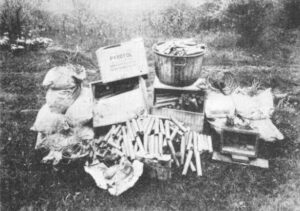
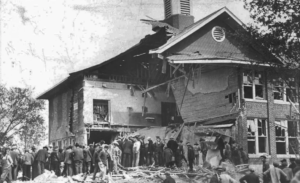 and was an accommodating neighbor and friend. But behind his ordinary demeanor was a narcissistic sadist seething with rage, resentment, and paranoia. To say that something in his life was to blame for his rage is really far fetched. To say that he was mentally ill might be more accurate. It’s hard to say if counseling could have helped either. It is something we will never know.
and was an accommodating neighbor and friend. But behind his ordinary demeanor was a narcissistic sadist seething with rage, resentment, and paranoia. To say that something in his life was to blame for his rage is really far fetched. To say that he was mentally ill might be more accurate. It’s hard to say if counseling could have helped either. It is something we will never know.

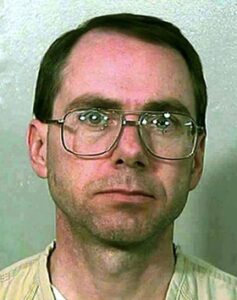 April 19, 1995 was a normal spring morning in Oklahoma City, Oklahoma, but by 9:02am, all that would change forever. This was the day that antigovernment extremists, Timothy McVeigh and Terry Nichols had chosen to tell the world that they didn’t like things going the way they were. The biggest problem was not that they wanted to protest, because that is their right, but it was the way they chose to protest that was completely criminal.
April 19, 1995 was a normal spring morning in Oklahoma City, Oklahoma, but by 9:02am, all that would change forever. This was the day that antigovernment extremists, Timothy McVeigh and Terry Nichols had chosen to tell the world that they didn’t like things going the way they were. The biggest problem was not that they wanted to protest, because that is their right, but it was the way they chose to protest that was completely criminal.
That morning, McVeigh parked a Ryder truck in front of the Alfred P Murrah Federal Building and then, he walked away. No warning was issued, because nothing was considered to be out of place, but that day about a thousand people started their day in the building, only to have their lives forever changed, or ended. The bomb went off at 9:02am, and in that moment, more than one-third of the building was destroyed, 168 people lost their lives, and about 800 were injured. The dead included 19 children in the on-site daycare facility. The blast destroyed or damaged 324 other buildings within a 16-block radius, shattered glass in 258 nearby buildings, and destroyed or burned 86 cars, causing an estimated $652 million worth of damage. In response to the attack, local, state, federal, and worldwide agencies quickly mobilized in extensive rescue. The Federal Emergency Management Agency (FEMA) activated 11 of its Urban Search and Rescue Task Forces, consisting of 665 rescue workers who assisted in rescue and recovery operations.
The investigation moved rapidly, and within 90 minutes of the explosion, McVeigh was stopped by Oklahoma Highway Patrolman Charlie Hanger for driving without a license plate and arrested for illegal weapons possession. It seems that most criminals make mistakes that lead to their downfall. Forensic evidence quickly 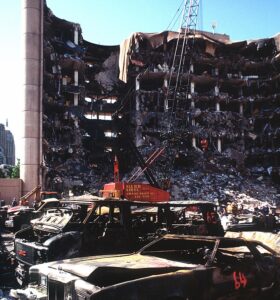
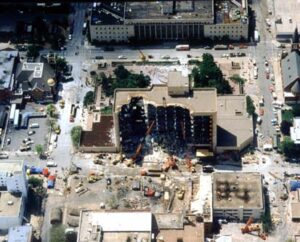 linked McVeigh and Nichols to the attacks. Nichols was arrested and within days, both were charged. Michael and Lori Fortier were later identified as co-conspirators. McVeigh, a veteran of the Gulf War and a sympathizer with the US militia movement, had detonated the Ryder rental truck filled with explosives and Nichols had assisted with the bomb’s preparation. Motivated by his dislike for the US federal government and unhappy about its handling of the Ruby Ridge incident in 1992 and the Waco siege in 1993, McVeigh timed his attack to coincide with the second anniversary of the fire that ended the siege at the Branch Davidian compound in Waco, Texas.
linked McVeigh and Nichols to the attacks. Nichols was arrested and within days, both were charged. Michael and Lori Fortier were later identified as co-conspirators. McVeigh, a veteran of the Gulf War and a sympathizer with the US militia movement, had detonated the Ryder rental truck filled with explosives and Nichols had assisted with the bomb’s preparation. Motivated by his dislike for the US federal government and unhappy about its handling of the Ruby Ridge incident in 1992 and the Waco siege in 1993, McVeigh timed his attack to coincide with the second anniversary of the fire that ended the siege at the Branch Davidian compound in Waco, Texas.
I could never understand why terrorists consider it necessary to take out so many innocent lives in order to make their grievances known. The official FBI investigation was known as “OKBOMB” involved 28,000 interviews, 3.5 short tons of evidence and nearly one billion pieces of information. The bombers were tried and convicted in 1997. McVeigh was sentenced to death, and was executed by lethal injection on June 11, 2001, at the US federal penitentiary in Terre Haute, Indiana. Nichols was sentenced to life in prison in 2004. Michael and Lori Fortier testified against McVeigh and Nichols, in exchange for a plea-deal. Michael Fortier was sentenced to 12 years in prison for failing to warn the United States government, and Lori received immunity from prosecution in exchange for her testimony. Michael was released into witness protection in 2006.
The US Congress passed the Antiterrorism and Effective Death Penalty Act of 1996, which tightened the standards for habeas corpus in the United States n response to the bombing. It also passed legislation to increase the protection around federal buildings to deter future terrorist attacks. Prior to the September 11th attacks in 2001, the Oklahoma City bombing was the deadliest terrorist attack in the history of the United 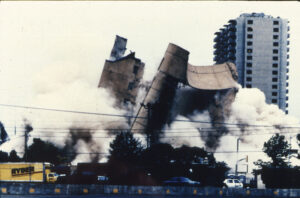
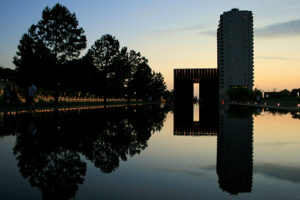 States, other than the Tulsa race massacre. It remains one of the deadliest acts of domestic terrorism in US history. On April 19, 2000, the Oklahoma City National Memorial was dedicated on the site of the Murrah Federal Building, commemorating the victims of the bombing. Remembrance services are held every year on April 19, at the time of the explosion.
States, other than the Tulsa race massacre. It remains one of the deadliest acts of domestic terrorism in US history. On April 19, 2000, the Oklahoma City National Memorial was dedicated on the site of the Murrah Federal Building, commemorating the victims of the bombing. Remembrance services are held every year on April 19, at the time of the explosion.
 So many of the men and women who return from combat, when many of their buddies didn’t, suffer from a multitude of feelings. Many feel like it should been them killed in the bombing, shooting, plane crash, or whatever it might have been that took their buddy or buddies, and somehow let them alive. No matter that they were quite possibly wounded too, maybe even lost a limb. The point was that somehow they had come back alive, and they carry the guilt of that with them always.
So many of the men and women who return from combat, when many of their buddies didn’t, suffer from a multitude of feelings. Many feel like it should been them killed in the bombing, shooting, plane crash, or whatever it might have been that took their buddy or buddies, and somehow let them alive. No matter that they were quite possibly wounded too, maybe even lost a limb. The point was that somehow they had come back alive, and they carry the guilt of that with them always.
Some of those returning heroes struggle with the loss of their feeling all their lives. Some of them take risks, feeling like they are living on borrowed time, and if their time comes, it will almost be a form of justice. Some feel 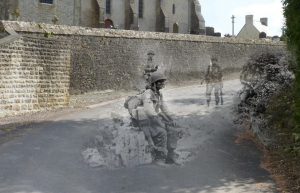 like it is borrowed time, but look at it more like living a gift. They might try to live up to what they think would make their buddies would be proud of. It doesn’t matter how they live their lives, for some, it will never be enough…in their minds anyway. They feel like their buddy died, and because of that, they can have a family…one their buddy never got to have. And if those buddies who were lost had a family, they feel an even greater burden, because not only did their buddy lose out of being with his family, but the family lost him too.
like it is borrowed time, but look at it more like living a gift. They might try to live up to what they think would make their buddies would be proud of. It doesn’t matter how they live their lives, for some, it will never be enough…in their minds anyway. They feel like their buddy died, and because of that, they can have a family…one their buddy never got to have. And if those buddies who were lost had a family, they feel an even greater burden, because not only did their buddy lose out of being with his family, but the family lost him too.
War is not an easy thing to go through, and those of us who are home, especially those of us with no one in the war, cannot really understand what  they go through either in the war, or after the war. It’s impossible. There are other kinds of survivors guilt, and I don’t suppose one is easier than the other, but it seems to me that because of the trust, companionship, and love these men feel for each other; and the idea that in the end, he couldn’t save the buddy or buddies who he felt were somehow his responsibility…well, it would be devastating. I can’t even begin to imagine. And the mind is a tough thing to get past, once it gets an idea firmly ingrained in it. For many soldiers, finally deciding that they aren’t living on borrowed time is a lifelong process, and all their family can do is pray they can make the transition back to living life again. I pray they can too.
they go through either in the war, or after the war. It’s impossible. There are other kinds of survivors guilt, and I don’t suppose one is easier than the other, but it seems to me that because of the trust, companionship, and love these men feel for each other; and the idea that in the end, he couldn’t save the buddy or buddies who he felt were somehow his responsibility…well, it would be devastating. I can’t even begin to imagine. And the mind is a tough thing to get past, once it gets an idea firmly ingrained in it. For many soldiers, finally deciding that they aren’t living on borrowed time is a lifelong process, and all their family can do is pray they can make the transition back to living life again. I pray they can too.
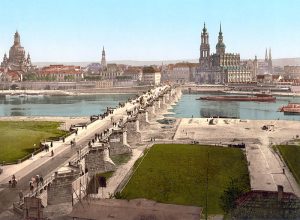
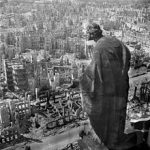 The American prisoners of war had heard the Allied planes pass overhead many times before, but this was different. Along with the sound of the planes, came the howling of Dresden’s air raid sirens. Dresden was known as the “Florence of the Elbe.” The American prisoners of war were moved two stories below into a meat locker. I don’t really understand that in light of the outcome. The Germans didn’t care about their prisoners, but I guess they didn’t care about their own countrymen either. Why would they move their prisoners to a place of safety, but leave the people of the town to fend for themselves. I suppose that they might have wanted the prisoners for leverage, but how good is a victory, if there are no one to live in the town.
The American prisoners of war had heard the Allied planes pass overhead many times before, but this was different. Along with the sound of the planes, came the howling of Dresden’s air raid sirens. Dresden was known as the “Florence of the Elbe.” The American prisoners of war were moved two stories below into a meat locker. I don’t really understand that in light of the outcome. The Germans didn’t care about their prisoners, but I guess they didn’t care about their own countrymen either. Why would they move their prisoners to a place of safety, but leave the people of the town to fend for themselves. I suppose that they might have wanted the prisoners for leverage, but how good is a victory, if there are no one to live in the town.
In this instance, I suppose it didn’t matter, because when the prisoners were brought back to the surface, “the city was gone”…levelled by the bombs from the RAF and the USAAF. One prisoner, Kurt Vonnegut who was a writer and social critic, recalled the scene…shocked. The devastation was unbelievable, the bombing had reduced the “Florence of the Elbe” to rubble and flames. Still, Vonnegut could not help but be thankful that he was still alive. Who wouldn’t be thankful. He was alive, and he would be forever thankful. Who wouldn’t be. It was a second chance.
The devastating, three-day Allied bombing attack on Dresden from February 13 to 15, 1945 in the final months of World War II became one of the most controversial Allied actions of the war. Some 2,700 tons of explosives and incendiaries were dropped by 800-bomber raid and decimated the German city.
Dresden was a major center for Nazi Germany’s rail and road network. The plan was to destroy the city, and thereby overwhelm German authorities and services, and clog all transportation routes with hordes of refugees. An estimated 22,700 to 25,000 people were killed, in the attacks. Normally, Dresden had 550,000 citizens, but at the time there were approximately 600,000 refugees too. The Nazis tried to say that 550,000 had been killed, but that number was quickly proven wrong.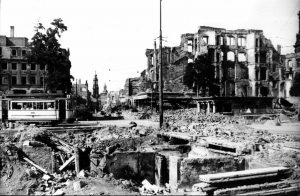

The Allied assault came a less than a month after 19,000 US troops were killed in Germany’s last-ditch offensive at the Battle of the Bulge, and three weeks after the grim discovery of the atrocities committed by Nazi forces at Auschwitz. In an effort to force a surrender, the Dresden bombing was intended to terrorize the civilian population locally and nationwide. It certainly had that effect in 1945.
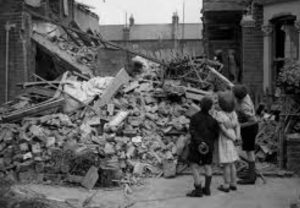 The Blitz was a German bombing offensive against Britain in 1940 and 1941, during World War II. The term was first used by the British press and is the German word for lightning. When the Germans bombed London in the Blitz bombing, the nerves of the people were very much on edge. They spent most of their nights in hiding in the subway tunnels. When they emerged, they had no idea what to expect. Most of them knew that their beloved city would be very different than it was before, and they knew that, in reality, it may never be the same. Yes, it could be rebuilt, but it would never…never be the same. The adults felt sick a they looked at the city they loved, but the
The Blitz was a German bombing offensive against Britain in 1940 and 1941, during World War II. The term was first used by the British press and is the German word for lightning. When the Germans bombed London in the Blitz bombing, the nerves of the people were very much on edge. They spent most of their nights in hiding in the subway tunnels. When they emerged, they had no idea what to expect. Most of them knew that their beloved city would be very different than it was before, and they knew that, in reality, it may never be the same. Yes, it could be rebuilt, but it would never…never be the same. The adults felt sick a they looked at the city they loved, but the  adults were not the only people who were looking at the devastation.
adults were not the only people who were looking at the devastation.
Some of the saddest pictures taken after the Blitz bombings, were those taken of the children. I can’t imagine what must have been going through their minds as they looked at the devastation that was once their home. They had spent so many wonderful hours playing in their bedrooms, and now they had no bedrooms, or even a house for that matter. Their home had been reduced to a pile of rubble. Sitting there looking at what little is left, some children find a little bit of solace in the fact that a doll or something similar managed to survive the carnage…and they feel somehow blessed. And, of course, they are blessed, because for so many others, there is nothing left.
I’m sure that those little ones looked to their parents, hoping to see a spark of hope, or a little bit of encouragement, but all they saw was a look of shock and disbelief on the  faces of their parents. That only served to create a deeper sense of concern in the children. What was going to happen to them now? Where would they live? And the really sad thing was that their parents are wondering the same things. These are the faces of war. We often think of the soldiers, usually facing off with the enemy. Yes, sometimes we think of the civilians, but most of us almost try not to think of them, because we can imagine what they are going through. The news photographers, however, have to see the civilians. They have to photograph the destruction. It is their job, but when we see those stories, with their necessary pictures, we really see how war affects the civilians, especially the children. And we are horrified.
faces of their parents. That only served to create a deeper sense of concern in the children. What was going to happen to them now? Where would they live? And the really sad thing was that their parents are wondering the same things. These are the faces of war. We often think of the soldiers, usually facing off with the enemy. Yes, sometimes we think of the civilians, but most of us almost try not to think of them, because we can imagine what they are going through. The news photographers, however, have to see the civilians. They have to photograph the destruction. It is their job, but when we see those stories, with their necessary pictures, we really see how war affects the civilians, especially the children. And we are horrified.
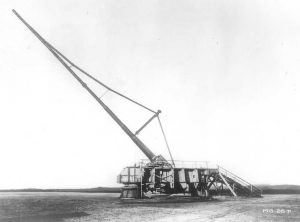
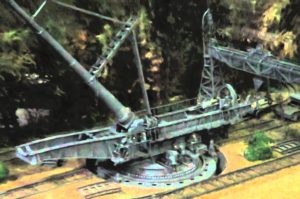 It seems as if the nations will never be satisfied until they have a new and stronger weapon that will easily destroy a massive amount of people in one shot. Wars are a part of life here on Earth, and will be until the end of time, so we might as well get used to that fact. World War I was not a different time when it comes to weapons of war, in fact on March 23, 1918 at 7:20am, an explosion took place in the Place de la Republique in Paris, and it hailed the first attack of a new German gun. The Pariskanone, Paris-Geschütz, or Paris gun, as it came to be known, was manufactured by Krupps. The Pariskanone was 210mm, with a 118-foot-long barrel. It could fire a shell an impressive distance of some 130,000 feet…25 miles into the air. Three of them fired on Paris that day from a gun site at CrÉpy-en-Laonnaise, a full 74 miles away. The city of Paris was reeling. Paris had withstood all earlier attempts at its destruction, including scattered bombings, but this would be different. It was first thought by the Paris Defense Service, that the city was being bombed, but soon they determined that it was actually being hit by artillery fire. It was a previously unimagined situation. I’m sure everyone wondered how the Germans could have made such a weapon.
It seems as if the nations will never be satisfied until they have a new and stronger weapon that will easily destroy a massive amount of people in one shot. Wars are a part of life here on Earth, and will be until the end of time, so we might as well get used to that fact. World War I was not a different time when it comes to weapons of war, in fact on March 23, 1918 at 7:20am, an explosion took place in the Place de la Republique in Paris, and it hailed the first attack of a new German gun. The Pariskanone, Paris-Geschütz, or Paris gun, as it came to be known, was manufactured by Krupps. The Pariskanone was 210mm, with a 118-foot-long barrel. It could fire a shell an impressive distance of some 130,000 feet…25 miles into the air. Three of them fired on Paris that day from a gun site at CrÉpy-en-Laonnaise, a full 74 miles away. The city of Paris was reeling. Paris had withstood all earlier attempts at its destruction, including scattered bombings, but this would be different. It was first thought by the Paris Defense Service, that the city was being bombed, but soon they determined that it was actually being hit by artillery fire. It was a previously unimagined situation. I’m sure everyone wondered how the Germans could have made such a weapon.
Before the day was over, the shelling had killed 16 people and wounded 29 more. The Germans continued the shelling of that year in several phases between March 23 and August 9, 1918. Over that time, the gun caused a total of 260 deaths in Paris. It was a low number due to the fact that the residents of Paris quickly learned to avoid gathering in large groups during periods of shelling. With less people in each area, the casualties were limited substantially. Nevertheless, the weapon had a terrifying effect on the people and a horrific impact on property in the areas of the shelling. Almost all information about the Pariskanone, one of the most sophisticated weapons to emerge out of World War I, disappeared after the war ended. Later, the Nazis tried 
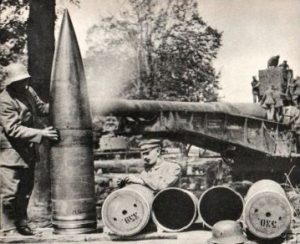 without success to reproduce the gun from the few pictures and diagrams that remained. Copies were deployed in 1940 against Britain across the English Channel, but failed to cause any significant damage….a good thing for the people of the Britain at that time. When I look at the pictures of the weapon, I am reminded of the old “Wild, Wild, West” show. There always seemed to be some strange new fangled weapon of destruction in use there too.
without success to reproduce the gun from the few pictures and diagrams that remained. Copies were deployed in 1940 against Britain across the English Channel, but failed to cause any significant damage….a good thing for the people of the Britain at that time. When I look at the pictures of the weapon, I am reminded of the old “Wild, Wild, West” show. There always seemed to be some strange new fangled weapon of destruction in use there too.
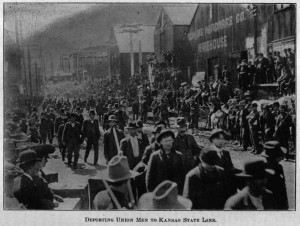 I think a lot of people know or at least have heard of Cripple Creek, Colorado. Most people think of the fourteen casinos located there, and I suppose that casinos are a fitting thing for Cripple Creek to be known for, but it wasn’t always that way. Cripple Creek became a gold mining boom town in 1894 after gold was discovered there. At that time 150 gold mines suddenly sprang up, and with them, a strong miners union…the Free Coinage Union Number 19, which was a part of the militant Western Federation of Miners.
I think a lot of people know or at least have heard of Cripple Creek, Colorado. Most people think of the fourteen casinos located there, and I suppose that casinos are a fitting thing for Cripple Creek to be known for, but it wasn’t always that way. Cripple Creek became a gold mining boom town in 1894 after gold was discovered there. At that time 150 gold mines suddenly sprang up, and with them, a strong miners union…the Free Coinage Union Number 19, which was a part of the militant Western Federation of Miners.
As with any gold mining operation, desparate workers began pouring in from all over the country. Before long Cripple Creek had a huge labor surplus. With the labor surplus, the owners begin requiring extra hours, with no pay increase, or the alternative, they could keep the current 8 hours a day with a pay reduction of 50 cents. The Western Federation of Miners opposed both plans, and the miners when on strike. Their picket lines and refusal to work closed most of the mines. They showed what solidarity is all about. The miners who were still going down in the 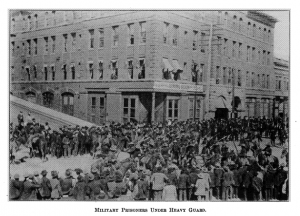 working mines assessed themselves 10 percent of their wages to support the strikers, and the union set up soup kitchens. How often to you see people who can’t afford to strike, but who are willing to support those who do strike.
working mines assessed themselves 10 percent of their wages to support the strikers, and the union set up soup kitchens. How often to you see people who can’t afford to strike, but who are willing to support those who do strike.
The governer of Colorado, David Waite would not help the labor bosses, but they had the county Sheriff, Frank Bowers in their pocket. They told the miners to go back to work, they would not. By the end of October, things had gotten so out of hand that finally, on November 23, 1903, Governor Peabody agreed to send the state miltia to protect replacement workers that the bosses had brought in. The striking miners were furious and they barricaded the roads and railways. The soldiers began rounding up the union members and their sympathizers, including the entire staff of a pro-union newspaper, and imprisoned them without charges or any evidence that they had done anything wrong.
The miners and others who were imprisoned complained that their constitutional rights had been violated, and 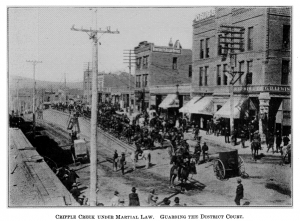
one anti-union judge replied, “To hell with the Constitution; we’re not following the Constitution!” Those tactics brought out the more radical elements of the Western Federation of Miners, and in June of 1904 Harry Orchard, who was a professional terrorist the the union employed, blew up a railroad station, whick killed 13 strikebreakers. With the bombing came the outrage of the public and the deportation of the Western Federation of Miners leaders. By midsummer, the strike was over and the Western Federation of Miners never regained the same level of power it had originally had in the Colorado mining districts. Even in this day and age, the unions and the bosses seem to always be at odds, and I suppose that something like this could happen again.

